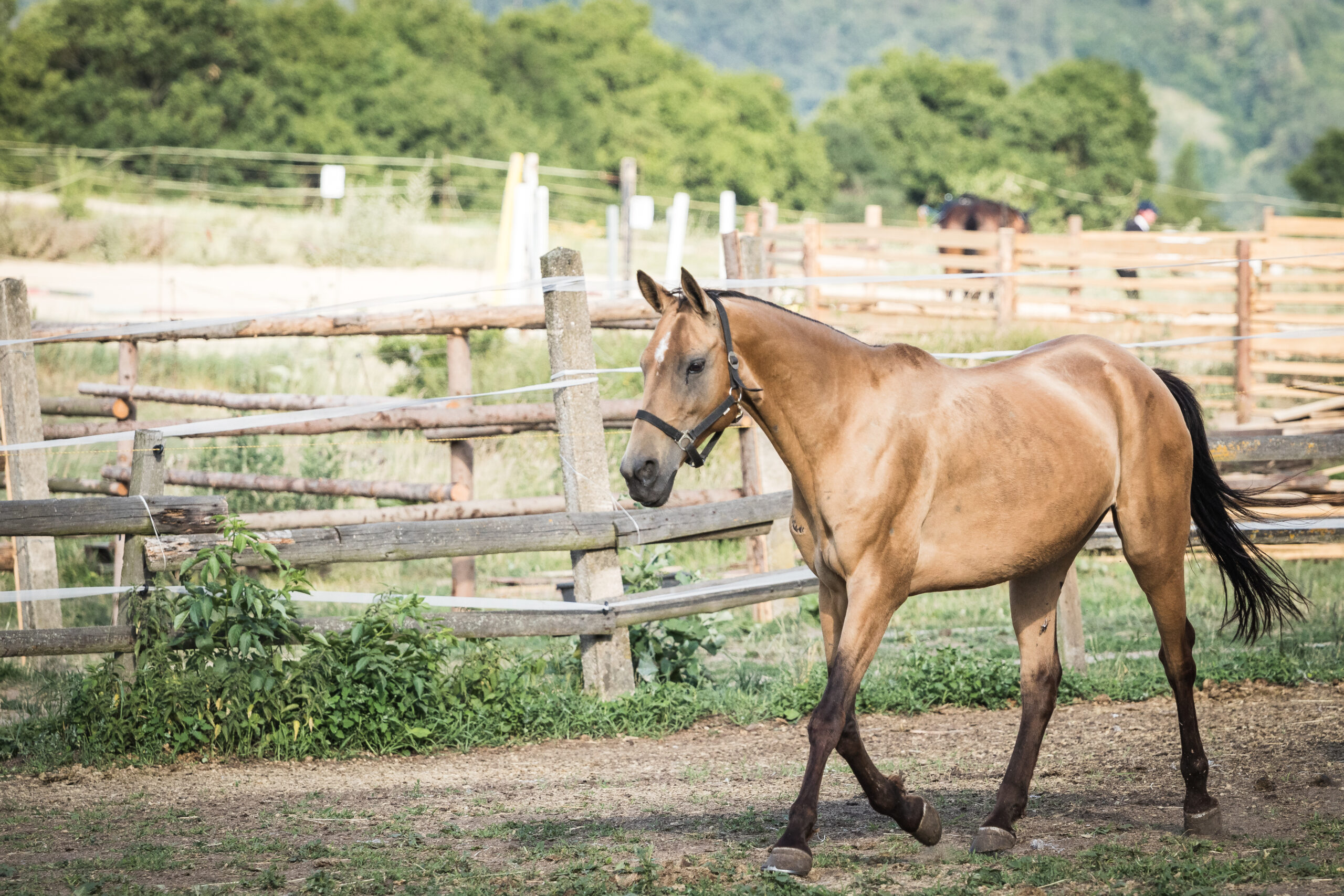Dazzling Akhal Teke horses are one of the world’s most eye-catching breeds. Turkmenistan is their original homeland. The ancestors of these golden-coated horses are likely to have lived in this region for hundreds of years, making them one of the world’s oldest breeds. Perhaps Akhal Tekes were even the “Heavenly Horses,” which were written about in legends long ago!
Akhal Teke – History and Origins
Whether they are the Heavenly Horses or not, they have an intriguing history. It is closely tied to the Turkmen people, who treasure their golden beauties with coats that shine like polished metal. It’s now known that modern domesticated horses were developed by humans on the steppe to the north of the Black Sea. Starting from here, horses were acquired and used by many other people.
The Turkmen people were originally a tribe from Central Asia who were famous for their skill with horses. They probably originated near Lake Baikal in Siberia. As nomads, they moved around and finally migrated to the area of modern-day Turkmenistan in the 8th century CE. This territory, mostly covered by the Karakum Desert, lies to the southeast of the Caspian Sea.
One of the powerful Turkmen tribes was named Teke. The name Akhal Teke can be translated as “horses of the Teke people from the oases of Akhal.” Oases are very important places to herders as they need to know where they can regularly water their animals in the desert.

The name Akhal Teke can be translated as “horses of the Teke people from the oases of Akhal.
How much do Akhal Teke Horses cost?
While it’s possible to find horses under $10,000, it’s not unusual for an Akhal Teke sports horse to cost over $50,000.
Tales of the Heavenly Horses
Tall, lean Akhal Tekes also look similar to the horses buried in tombs at Pazyryk in Siberia. Some of these burials are 3,000 years old. When archaeologists excavated the tombs they discovered not only human remains, but also the bodies of horses dressed in fantastic harnesses. Their wonderful headdresses, shaped like deer antlers, were made from colored felt. The excavators wondered whether these horses buried in high-status tombs could be examples of the famous Heavenly Horses.
These legendary horses were desirable to rulers in ancient times. References in various documents suggest they were special because they had almost supernatural powers of endurance. They were said to never tire, and to sweat blood! Powerful kings and emperors along the Silk Road all the way to China coveted them. They came from the Ferghana Valley, which is in present-day Uzbekistan, Kyrgyzstan, and Tajikistan. The Chinese wanted these horses so badly they went to war over them.
It has been suggested that Alexander the Great’s horse Bucephalus was an early example of this type of horse. Alexander wanted to incorporate the region from which they came into his world empire. It’s also speculated that these were the horses the Romans knew as the Nisaean breed. The name Akhal Teke is relatively modern, dating only to 1881 when the Turkmenistan region came into the Russian sphere of influence. For many years, Turkmenistan was a republic within the USSR. Interestingly, this breed is known as the Argamak in Russian, as this means “divine looking.”
All the evidence does suggest that some of the ancestors of the Akhal Teke were the Heavenly Horses of legend. In late medieval and early modern times, European writers referred to the “Turkoman” horse, which was imported into Europe in considerable numbers. This type of horse is now known to have made an important contribution to the modern Thoroughbred. Today, this lovely modern Turkmen horse is the symbol of Turkmenistan and Turkmen identity.
Why is the Akhal Teke endangered?
There are very few examples of this breed outside Turkmenistan, where it has always been an elite animal. Total numbers globally are under 10,000. Historically, this breed has been at risk due to geopolitical uncertainty. This is a breed that requires specialist knowledge and handling, therefore, numbers are never likely to increase greatly.
Conformation
The distinctive conformation of the Akhal Teke gives it a greyhound-like appearance. They are long, lean, and clearly built to run fast. They have long faces with long ears, large nostrils, and almond-shaped, rather than round eyes. It is believed their conformation results from the harsh conditions in which they were bred and raised. These features have developed to cope with extremes of heat and cold, desert conditions, and sandstorms. The face tends to be convex rather than concave or straight.
Their long necks appear almost upright when they are moving, giving them a very different look than any other horse or pony in motion. Their backs are long, and withers high and prominent. They have a tendency to sickle hocks, though their front legs are notably straight. In height, they range from 14.2 hands (58 inches/147 cm) to 16 hands (64 inches/163 cm) high.
They generally weigh between 900 lb (408 kg) and 1000 lb (454 kg). Manes and tails are fine and not abundant, and the tails are sometimes carried high. Their feet are relatively small yet are some of the strongest of all the horse breeds. When it comes to their looks, horse enthusiasts are divided. Some love the lean, hound-like aspect of these striking animals. Others dislike their appearance!
Video of Akhal Teke
Coats of Many Colors
Akhal Tekes have an extensive range of coat colors, ranging from black through red variations, to gray. The red base coat exhibits different shades of bay, chestnut, and palomino. This horse breed is noted for having a metallic sheen to the coat, which is particularly apparent in the cremello, pale gold, and light chestnut individuals. It is not unique to the Akhal Teke.
Some of the Russian breeds, as well as horses of the Caucasus, also display this wonderful coat quality. However, it is true to say that no other breed has this extraordinary trait to such a degree. Akhal Tekes can also be perlino, dun and buckskin. White markings such as socks, stockings, blazes, and stars are found frequently, adding to the appeal of these elegant animals. They also have a range of eye colors, including blue and occasionally blue-green.

The Akhal Teke can grow to 16 hands tall and weigh up to 1000lb.
Characteristics of the Akhal Teke
Among the nomadic Turkmen, the Akhal Teke horse always lived as a member of the family. They were valued and cherished. The modern breed also thrives in an environment that encourages a close bond between horse and human. They can be strong-willed. Being fast, athletic, and sensitive horses, they are best partnered by experienced riders.
They keep the qualities of endurance and ability to cope with extremes of temperature inherited from their desert ancestors. These traits were tested to the full during the 1930s when Turkmen riders rode across over 200 miles of desert in just three days without any water. These horses are still relatively rare outside Turkmenistan. Breeding and training them is a specialist activity.

The horses are perfect racehorses because of their stature and good condition.
Akhal Teke – Breeding and Uses
Breeding Akhal Teke horses has always been a highly intensive endeavor. They were traditionally kept for racing. The Turkmen trainers used to blanket their horses most of the time when not taking part in races. Seven blankets were used traditionally, and the horses were fed a high protein diet. This included unusual foodstuffs such as eggs, butter, and even mutton fat! Today, these horses compete successfully in many equestrian activities.
They have always been a highly rated riding and competition horse in the countries of the former Soviet Union. They were also influential in the creation of several other Russian breeds. The Russian stallion Absent was a successful dressage horse in the USSR. They can compete successfully in any sphere, which requires athleticism, and make outstanding endurance horses. Since the 1990s in the USA, the Niimíipuu (Nez Percé) people have worked closely with Turkmen breeders to produce a new breed, the Nez Percé Spotted Horse. It is a cross between the Appaloosa and the Akhal Teke.
Are Akhal Teke good horses?
In the right hands, this horse is an exceptional athlete. However, they are not the easiest horses to train. This breed can be an excellent choice for competitive, skilled riders who can rise to a challenge.
Diet and Nutrition
Most modern keepers of Akhal Teke horses outside Turkmenistan will likely not adopt the traditional methods used when training them for racing! Originating in a tough environment, they will thrive on basic fodder, including high-quality hay. When in intensive work, they will, of course, require a specialist diet of high protein and carbohydrates, selected and balanced by equine nutritionists. This is an area in which specialist knowledge is required.
Health and Behavior
This breed is essentially tough and hardy. Their lungs, hearts, and stamina are all excellent. However, due to the small gene pool, there is a risk of cervical vertebral malformation (wobbler syndrome). Foals can suffer from hairless foal syndrome. They are not the easiest horses to handle and are best matched with experienced riders. They require sensitivity, skill, and patience.

